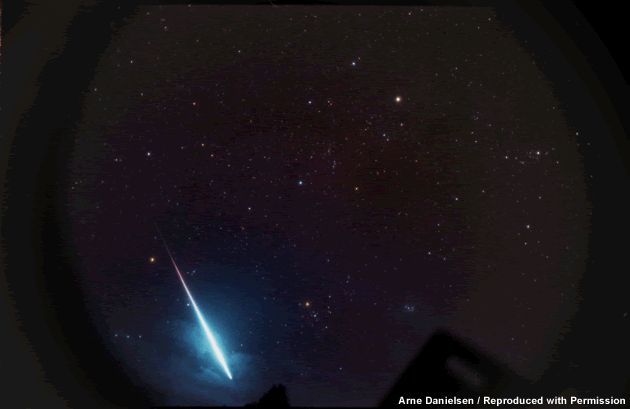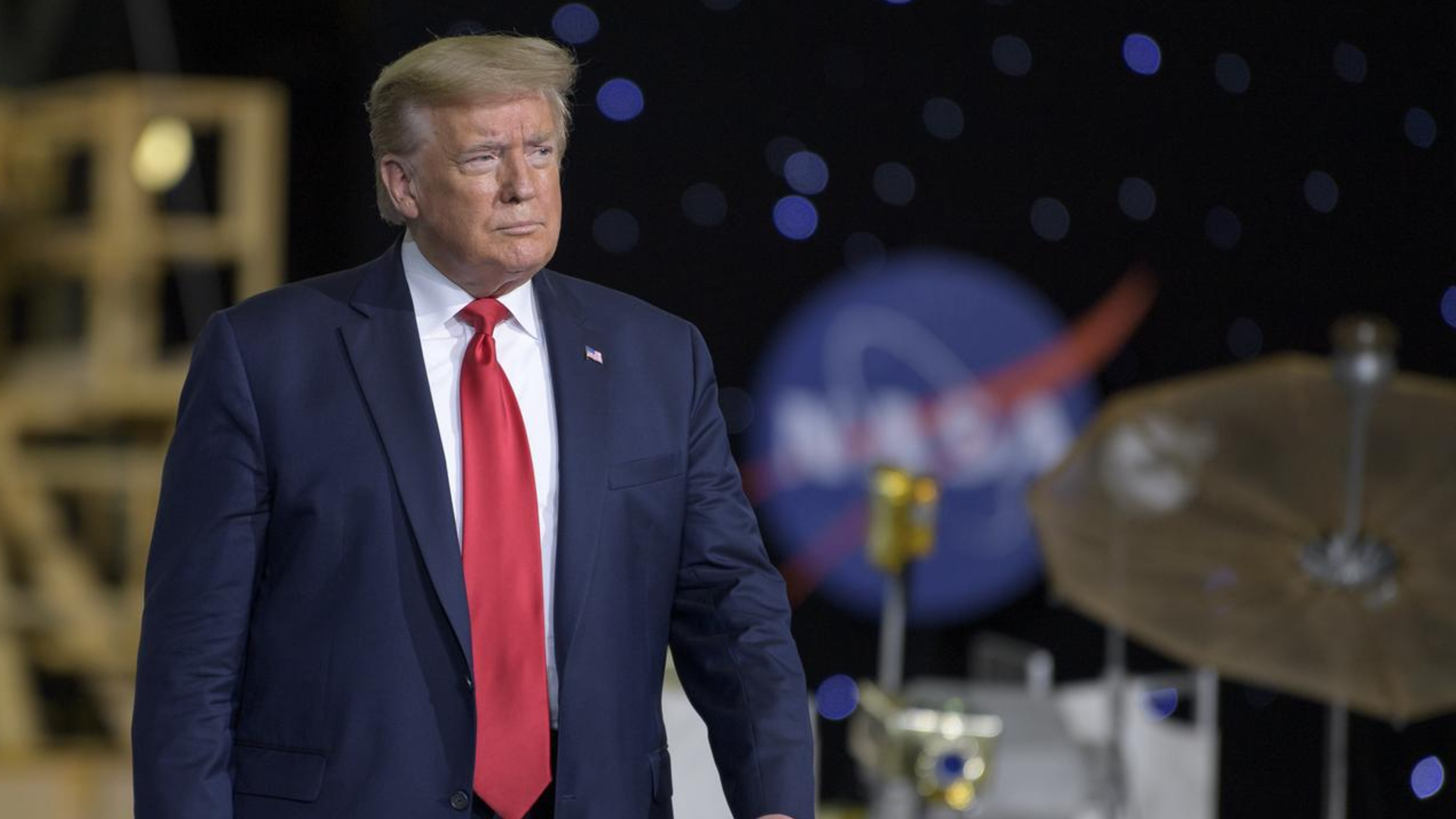Drizzle of Shooting Stars Expected Friday Morning

Updated Nov. 18
What's Expected Friday Morning
This week brings us the return of the famous Leonid Meteor Shower, a meteor display that over the past several years has brought great anticipation and excitement to sky watchers around the world.
Solely from the standpoint of viewing circumstances, this will be a favorable year to look for these meteors, since the Moon will be only a thin crescent and will have set in the west long before the constellation Leo (from where the meteors get their name) begins to rise. This is in stark contrast to 2002 when a nearly full Moon lit up the sky like a spotlight and wiped out all but the brightest meteors.
Last year, conditions were much better; the Moon had slimmed to a narrow crescent in the predawn morning sky and offered little hindrance. But this year, the Moon will be out of the sky completely, offering perfect viewing conditions.
The Leonid meteors are debris shed into space by the Tempel-Tuttle comet, which swings through the inner solar system at intervals of 33 years. With each visit the comet leaves behind a trail of dust in its wake.
Lots of the comet's old dusty trails litter the mid-November part of Earth's orbit and the Earth glides through this debris zone every year. Occasionally we'll pass directly through an unusually concentrated dust trail, or filament, which can spark a meteor storm resulting in thousands of meteors per hour. That's what happened in 1999, 2001 and 2002.
Breaking space news, the latest updates on rocket launches, skywatching events and more!
Since the Tempel-Tuttle comet passed the Sun in 1998, it was in those years immediately following its passage that the Leonids put on their best show.
But now, the comet - and its dense trails of dust -- have all receded far beyond Earth's orbit and back into the outer regions of the solar system. So odds are that there is little, if any chance of any unusual meteor activity.
Times of (prospective) peak activity
In the 2004 Observer's Handbook of the Royal Astronomical Society of Canada, meteor experts Margaret Campbell-Brown and Peter Brown, indicate that this year's peak activity should occur on the morning of Nov. 17.
They cite 9:00 GMT, which corresponds to 4 a.m. EST and 1 a.m. PST. This is the moment when the Earth will be passing closest to the orbit of the long-departed comet, and when our planet seemingly is most likely to encounter some residual comet material. This time is highly favorable for North Americans, especially those in the eastern United States and eastern Canada.
But while Leonid rates are unpredictable, it is unlikely that more than a dozen meteors per hour will be seen this year during peak activity, at least for viewer's with dark skies away from cities.
Other meteor researchers, however, such as Jeremie Vaubaillon of France, David Asher of Ireland and Esko Lyytinen of Finland have examined Leonid prospects for this year and also suggest watching for some meteor activity two days later, on Nov. 19.
For instance: sometime around 6:40 GMT (1:40 a.m. EST) on the 19th, the Earth might interact with material that was shed by comet Tempel-Tuttle back in the year 1333. But at best, only about 10 Leonids per hour may be seen. Lyytinen even suggests that because of gravitational perturbations affecting these particles after making 20 trips around the Sun, that this sparse activity might actually take place several hours earlier, which would favor observers in Europe.
Later that same day, the Earth could possibly sweep through a fresher and somewhat more concentrated trail of material dating back to 1733. Perhaps a brief bevy of 30 to 60 Leonids per hour may seen, but the time frame when these meteors are predicted to be most numerous (approximately 19:00 to 22:00 GMT) favors observers in Asia and Australia (where it will be the early morning hours of Nov. 20).
How to watch
The meteors will appear to emanate from out of the so-called "Sickle" of Leo, but prospective viewers should not concentrate on that area of the sky around Leo, but rather keep their eyes moving around to different parts of the sky.
Because Leo does not start coming fully into view until the after midnight hours, that would be the best time to concentrate on looking for the Leonid meteors.
The hours after midnight are generally best for watching for "shooting stars" anyway, because before midnight we are riding on the back side of the Earth in its orbit around the Sun, whereas after midnight we are on the front or advancing side. After midnight the only meteoroids escaping collision are those ahead of the Earth and moving in the same direction with velocities exceeding 18.5 miles per second. All others we will either overtake or meet head-on. But before midnight, when we are on the backside, the only meteoroids we encounter are those with velocities high enough to overtake the Earth.
Therefore, on the average, morning meteors appear brighter and faster than those we see in the evening.
And because the Leonids are moving along in their orbit around the Sun in a direction opposite to that of Earth, they slam into our atmosphere nearly head-on, resulting in the fastest meteor velocities possible: 45 miles per second (72 kilometers per second). Such speeds tend to produce bright meteors, which leave long-lasting streaks or trains in their wake.
After Friday morning, the Leonids will tail off quickly. A few stragglers may be visible on subsequent mornings.
- How Meteor Showers Work
- Meteor Watching Tips
- The Power of a Shooting Star

Starry Night software brings the universe to your desktop. Map the sky from your location, or just sit back and let the cosmos come to you.
Joe Rao serves as an instructor and guest lecturer at New York's Hayden Planetarium. He writes about astronomy for The New York Times and other publications, and he is also an on-camera meteorologist for News 12 Westchester, New York.

Joe Rao is Space.com's skywatching columnist, as well as a veteran meteorologist and eclipse chaser who also serves as an instructor and guest lecturer at New York's Hayden Planetarium. He writes about astronomy for Natural History magazine, Sky & Telescope and other publications. Joe is an 8-time Emmy-nominated meteorologist who served the Putnam Valley region of New York for over 21 years. You can find him on Twitter and YouTube tracking lunar and solar eclipses, meteor showers and more. To find out Joe's latest project, visit him on Twitter.

